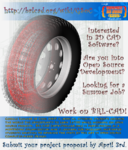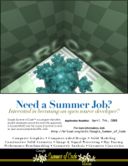Difference between revisions of "Google Summer of Code"
(emphasize checklist) |
(simplify, move application details to the guidelines page) |
||
| Line 3: | Line 3: | ||
'''BRL-CAD is applying to participate in the 2011 Google Summer of Code!''' | '''BRL-CAD is applying to participate in the 2011 Google Summer of Code!''' | ||
| − | Since 2005, Google has run an awesome open source software development program specifically for ''students'' called the [http://code.google.com/soc/ Google Summer of Code] (GSoC). Under this program, Google funds students to write code for open source projects during the northern hemisphere's summer timeframe | + | Since 2005, Google has run an awesome open source software development program specifically for ''students'' called the [http://code.google.com/soc/ Google Summer of Code] (GSoC). Under this program, Google funds students to write code for open source projects during the northern hemisphere's summer timeframe: |
| + | |||
| + | * The student writes up a project proposal to an open source organization such as BRL-CAD. | ||
| + | **Sometimes their project idea caters to something that the open source organization suggests and sometimes it's an idea entirely of the student's conception. | ||
| + | * Proposals are then reviewed, evaluated, and ranked by the open source organization's mentors. | ||
| + | * Google allocates a certain number of slots to each participating organization | ||
| + | ** That, in turn, determines how many student developers work with that organization. | ||
=Getting Started [[Google_Summer_of_Code/Checklist|Checklist]]= | =Getting Started [[Google_Summer_of_Code/Checklist|Checklist]]= | ||
| Line 9: | Line 15: | ||
Whether you're applying or accepted, we've itemized everything you need to do into a simple '''[[Google_Summer_of_Code/Checklist|CHECKLIST]]'''. We're here to help you become new open source developers, so don't be shy if you have any questions. | Whether you're applying or accepted, we've itemized everything you need to do into a simple '''[[Google_Summer_of_Code/Checklist|CHECKLIST]]'''. We're here to help you become new open source developers, so don't be shy if you have any questions. | ||
| − | =Preparing an application= | + | ==Preparing an application== |
| − | |||
| − | |||
| − | |||
| − | |||
| − | |||
| − | |||
| + | If you're a student interested in working on a project proposal for BRL-CAD, see our '''[[Google_Summer_of_Code/Application_Guidelines|GSoC application guidelines]]''' page. It's full of submission details, do's and don't hints, and more. | ||
| + | |||
= The application selection process = | = The application selection process = | ||
Revision as of 20:11, 11 March 2011
Contents
Overview
BRL-CAD is applying to participate in the 2011 Google Summer of Code!
Since 2005, Google has run an awesome open source software development program specifically for students called the Google Summer of Code (GSoC). Under this program, Google funds students to write code for open source projects during the northern hemisphere's summer timeframe:
- The student writes up a project proposal to an open source organization such as BRL-CAD.
- Sometimes their project idea caters to something that the open source organization suggests and sometimes it's an idea entirely of the student's conception.
- Proposals are then reviewed, evaluated, and ranked by the open source organization's mentors.
- Google allocates a certain number of slots to each participating organization
- That, in turn, determines how many student developers work with that organization.
Getting Started Checklist
Whether you're applying or accepted, we've itemized everything you need to do into a simple CHECKLIST. We're here to help you become new open source developers, so don't be shy if you have any questions.
Preparing an application
If you're a student interested in working on a project proposal for BRL-CAD, see our GSoC application guidelines page. It's full of submission details, do's and don't hints, and more.
The application selection process
Just about every GSoC project receives considerably more project proposals than can be accepted. Each proposal is reviewed, evaluated, and critiqued. Of those applications, only a small subset are selected so keep in mind that the selection process is rather competitive and difficult. This cannot be stressed enough.. It remains rather hard for most projects to narrow down the submissions but in the end we all only have so many slots to work with and the line eventually has to be drawn. Every application gets read multiple times and reviewed in detail. We thank everyone that submits a proposal to work on BRL-CAD.
In the end, submissions are selected according to the overall long-term impact that accepting the proposal can make, perception of the submitter's abilities to complete the task within the program timeframe, general consensus on the technical approach being proposed, and overall interest in having such modifications made to BRL-CAD. Particular notice is made of students that are responsive to questions and readily interactive in the IRC channel or on the mailing list. Communication is a good thing.
Students are expected to interact on the #brlcad IRC channel on the Freenode network, abide by the HACKING rules, agree to the Development Requirements, and focus on providing a clean maintainable implementation.
Thanks for your interest and we look forward to seeing students apply!
BRL-CAD participation in GSoC
You can check out promotional flyers that have been prepared in the past on our GSoC flyers page.
GSoC 2011
After a year off focusing on a major development initiative, BRL-CAD will once again be applying to participate in the Google Summer of Code.
GSoC 2009
For the second year in a row, BRL-CAD is participating in the Google Summer of Code. BRL-CAD was accepted as a participating organization and took upon five students, four of which successfully worked their projects and integrated with the development team.
GSoC 2008
The Google Summer of Code 2008 was announced on February 25, 2008. BRL-CAD was accepted as a participating organization and took upon four students, all of which successfully worked their projects and integrated with the development team.

